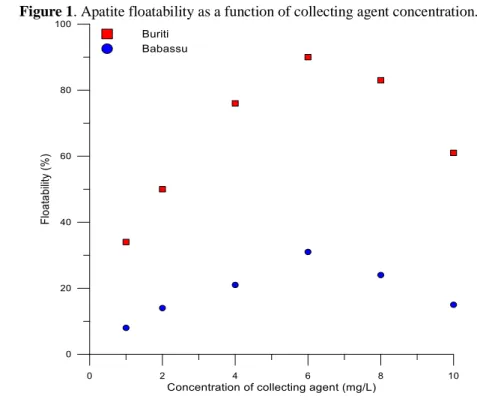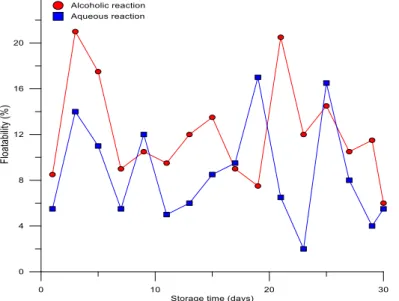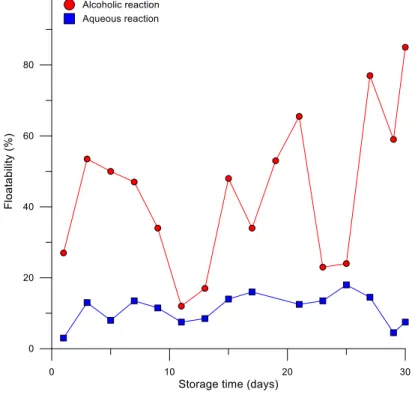Braz. J. of Develop., Curitiba, v. 6, n. 7, p. 49588-49594 jul. 2020. ISSN 2525-8761
Influence of the storage time of saponified Amazonic vegetable oils on the
floatability of apatita
Influência do tempo de armazenamento de óleos vegetais Amazônicos
saponificados na floatabilidade de apatita
DOI:10.34117/bjdv6n7-562
Recebimento dos originais: 03/06/2020 Aceitação para publicação: 22/07/2020
Ana Luiza Coelho Braga de Carvalho Environmental Process Engineering and Recycling
Institution: Clausthal University of Technology - Institute of Mineral and Waste Processing, Waste Disposal and Geomechanics - Department of Mineral and Waste Processing
Adress: Walther-Nernst-Straße 9 - 38678 Clausthal-Zellerfeld - Germany E-mail: lalcbdc18@tu-clausthal.de
David Rodrigues da Costa Chemical Engeneering Student
Institution: Universidade Federal do Sul e Sudeste do Pará
Adress: Folha 16, Quadra 10, Lote 1 A - Nova Marabá, Marabá – PA, Brazil E-mail: d.costa@unifesspa.edu.br
Denilson da Silva Costa Chemical Engeneering Doctor
Institution: Universidade Federal do Sul e Sudeste do Pará
Adress: Folha 16, Quadra 10, Lote 1 A - Nova Marabá, Marabá – PA, Brazil E-mail: denilson@unifesspa.edu.br
Larissa Thainá Feitosa Monteiro Chemical Engeneering Student
Institution: Universidade Federal do Sul e Sudeste do Pará
Adress: Folha 17, Quadra 04, Lote Especial, s/n.º - Nova Marabá, Marabá - PA, Brazil E-mail: larissatfmonteiro@gmail.com
ABSTRACT
This study's main objective is verifying the influence of the storage time of collectors reagents, obtained from Amazonian vegetable oils (Buriti and Babassu Coconut), in the apatite's floatability. Collectors were obtained by the oils' alkaline hydrolysis (saponification), made with aqueous and alcoholic solutions of sodium hydroxide at room temperature. The floatability of the apatite was evaluated through microflotation tests, done in a modified Hallimond tube, using a height extender to avoid entrainment. Approximately 1 g of the pure mineral (apatite) was used, with granulometry between 300 and 106 μm, pH 9.5, conditioning time of 4 minutes and aeration time of 1 minute. These microflotation tests were done every 2 days, from time 0, after the oils' saponification, up to 30 days of storage. The collector concentration used was 6 mg / L, defined from previous experiments. The results showed that the collector reagent, obtained from buriti oil’ saponification in an alcoholic solution of NaOH, presented better results.
Braz. J. of Develop., Curitiba, v. 6, n. 7, p. 49588-49594 jul. 2020. ISSN 2525-8761 Keywords: Microflotation, vegetable oil, apatite.
RESUMO
O objetivo principal deste estudo é verificar a influência do tempo de armazenamento de reagentes coletores, obtidos a partir de óleos vegetais da Amazônia (coco Buriti e Babaçu), na flutuabilidade da apatita. Os coletores foram obtidos pela hidrólise alcalina dos óleos (saponificação), feita com soluções aquosas e alcoólicas de hidróxido de sódio à temperatura ambiente. A flutuabilidade da apatita foi avaliada através de testes de microflotação, realizados em um tubo Hallimond modificado, utilizando um extensor de altura para evitar arrastamento. Foram utilizados aproximadamente 1 g do mineral puro (apatita), com granulometria entre 300 e 106 μm, pH 9,5, tempo de condicionamento de 4 minutos e tempo de aeração de 1 minuto. Esses testes de microflotação foram realizados a cada 2 dias, a partir do momento 0, após a saponificação dos óleos, até 30 dias de armazenamento. A concentração de coletor utilizada foi de 6 mg / L, definida a partir de experiências anteriores. Os resultados mostraram que o reagente coletor, obtido da saponificação do óleo de buriti em uma solução alcoólica de NaOH, apresentou melhores resultados.
Palavras-Chave: Microflotação, óleo vegetal, apatita.
1 INTRODUCTION
Finding new sustainability processes is something that grows every day in different sectors of production, and at mining it is not different. Searching for reagents that have high efficiency and selectivity for use in the concentration of phosphate ores (apatite) is quite challenging in Brazil.
The Amazon region has plant species that are huge candidates to be used as collector reagents in the flotation of ores. These species have as main characteristics the high availability and the fact that they are not used industrially in a significant amount yet. Furthermore, these inputs come from renewable and biodegradable sources, which would avoid problems of environmental aggression and adapt to the new scenario sought by the mineral industry. The use of these inputs would also add value to Amazonian species, contributing to the socio-economic development of the region (OLIVEIRA, 2013).
Researches have already proved the technical feasibility of using Amazonian vegetable oils as collector reagents for phosphate ores (COSTA, 2012). However, to use them as collectors in flotation, it is necessary to make them soluble in water through the saponification reaction, which is performed at high temperature and long reaction time. In addition to energy costs, the costs associated with the reagents used in this technique make its use economically unfeasible. In this sense, it is important to evaluate alternatives to do the economic viability of using them as collectors.
This way, this work had as main objective to evaluate the storage time of saponified vegetable oils in the apatite flotation. The oils chosen in this work were buriti oil and babassu oil because they have a vegetable origin and are predominant in the North and Northeast regions of Brazil.
Braz. J. of Develop., Curitiba, v. 6, n. 7, p. 49588-49594 jul. 2020. ISSN 2525-8761 2 MATERIAL AND METHODS
The mineral used was apatite, whose chemical composition obtained by X-ray Fluorescence (FRX), is P2O5 - 38.49%; K2O - 4.20%; CaO - 54.02%; SiO2 - 1.10%). This mineral was purchased
from Mineração Zé da Estrada-MG and underwent the following operations: comminution, magnetic separation, homogenization, and sample splitting. The particle size was between 300 µm and 106 µm.
The vegetable oils used (babassu and buriti) were acquired at a fair in the city of Marabá, southeastern Pará. Through Gas Chromatography (GC), the following fatty acid composition was obtained: a) babassu (43.92% of lauric acid; 16.07% myristic acid; 14.77% oleic acid; 8.52% palmitic acid; 3% stearic acid; 2.1% linoleic acid); b) buriti (70.55% oleic acid; 17.44% palmitic acid; 7.03% linoleic acid; 2.17% stearic acid; 1.08% linolenic acid).
The apatite floatability curves were made as a function of the concentration of the collector reagent (figure 1) to define the concentration used in the microflotation tests. For this curve, the alkaline hydrolysis (saponification) of each oil was performed using 2 g of oil and 50 mL of 2% (w / w) NaOH alcoholic solution. The reaction was performed in a three-necked round-bottom flask, in a heating blanket at 75ºC, for 30 minutes. After the reaction, the alcohol was evaporated and the hydrolysis product was transferred to a 1 L volumetric flask, made up with water.
The highest floatability was achieved at the concentration of 6 mg / L for both collectors. Therefore, this collector concentration was chosen to evaluate the influence of the storage time of the reagents on the recovery of apatite.
Braz. J. of Develop., Curitiba, v. 6, n. 7, p. 49588-49594 jul. 2020. ISSN 2525-8761
Once the concentration used in the microflotation tests was defined, the subsequent hydrolysis reaction were performed at room temperature, using aqueous and alcoholic NaOH solutions, for each oil used. For the reactions in aqueous solutions of buriti and babassu, 2 g of oil, 1 g of NaOH, and 1 L of distilled water were used. For reactions in alcoholic medium, 1g of oil, 0.5 g of sodium hydroxide and 0.5 L of alcohol were used. The four saponification systems were stirred for 45 minutes.
The products (collectors reagents) were stored in sealed volumetric flasks at a temperature of approximately 25ºC. The microflotation tests to evaluate the correlation between the storage time of the saponified oil and its performance as collector agents were made every 2 days, for 30 days. To prepare the 6 mg / L solutions of each oil, 3 mL of the 2000 mg / L solutions diluted in 1L of distilled water were used.
The microflotation tests were carried out in a modified Hallimond tube, set up on a magnetic stirring plate, using 1 g of apatite, conditioning time of the collector reagent of 4 minutes and aeration time of 1 minute. After the test, the floatated and sunken fraction was collected, filtered using filter paper, placed in an oven to dry for 2 days, and then weighed to calculate the floatability of the mineral. Tests with a high coefficient of variation were performed in triplicate.
3 RESULTS AND DISCUSSION
Figures 2 and 3 show the floatability of apatite as a function of the storage time of the collectors reagents for the two studied vegetable oils (buriti and babassu), obtained from hydrolysis reaction with NaOH in aqueous and alcoholic medium.
Figure 2. Apatite floatability as a function of storage time and hydrolysis method for the babassu oil.
Braz. J. of Develop., Curitiba, v. 6, n. 7, p. 49588-49594 jul. 2020. ISSN 2525-8761
Figure 2 shows that there was no significant difference in the behavior of the apatite floatability using water or ethyl alcohol in the saponification reaction, evidenced by the similarity of the curves. It is also noted that the recovery of apatite was low, reaching a maximum of 22%. There was also no increase in floatability with the storage time of the collector.
Figure 3. Apatite floatability as a function of storage time and hydrolysis method for the buriti oil.
Figure 3 show that the collector from buriti, obtained from the hydrolysis reaction in alcoholic medium, showed the best results for the apatite's floatability, reaching approximately 85% of recovery in the thirtieth day of storage. This fact shows that, for buriti oil, both storage time and the hydrolysis reaction in alcoholic medium, improved the performance of the reagent as apatite collector. According to Wang et al. (2009), this can be attributed to the alcohol presence which provides better contact between vegetable oil and NaOH.
Figure 4 compares the performance of the buriti and babassu collectors obtained from hydrolysis in alcoholic medium. Buriti oil showed better results of floatability than babassu oil.
Braz. J. of Develop., Curitiba, v. 6, n. 7, p. 49588-49594 jul. 2020. ISSN 2525-8761 Figure 4. Apatite floatability as a function of storage time and collecting agent.
This can be attributed to the fact that buriti oil contains some significant amount of oleic acid (approximately 70.00% of this unsaturated and long-chain fatty acid - 18 carbons). Babassu oil, on the other side, has significant levels of saturated fatty acids (43.92% lauric acid and 16.07% myristic acid). Brandão et al. (1994) concluded that unsaturated fatty acid salts are better collectors than saturated ones in the apatite flotation.
4 CONCLUSIONS
Babassu oil showed a low recovery of apatite, probably due to the low amount of unsaturated fatty acids.
In the buriti oil, both storage time of the reagent and the hydrolysis in alcoholic medium improved the hydrophobization of the mineral particles.
Buriti oil showed better floatability results than babassu oil, possibly due to a significant bigger amount of oleic acid in its chain.
Braz. J. of Develop., Curitiba, v. 6, n. 7, p. 49588-49594 jul. 2020. ISSN 2525-8761 REFERENCES
BRANDÃO, P. R. G., CAIRES, L. G., QUEIROZ, D. S. B. Vegetable Lipid Oil-Based Collectors in the Flotation of Apatite Ores. Minerals Engineering, v. 7, p. 917-925, 1994.
COSTA, D.S. Uso de óleos amazônicos na flotação de minérios fosfáticos. Tese de Doutorado. Programa de Pós-Graduação em Engenharia Metalúrgica, Materiais e de Minas, Universidade Federal de Minas Gerais, 176 p., 2012.
GUIMARÃES, R. C.; ARAÚJO, A. C.; PERES, A. E. C. Reagents in Igneous Phosphate Ores Flotation. Minerals Engineering. Printed in Great Britain, 2006.
OLIVEIRA, A. C. et al. Influência do método de saponificação de óleos vegetais amazônicos na flotabilidade da apatita. In XXVI Encontro Nacional de Tratamento de Minérios e Metalurgia Extrativa, Salvador-BA, 20143.


